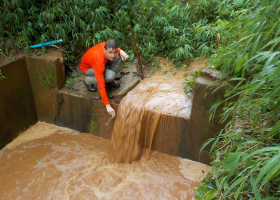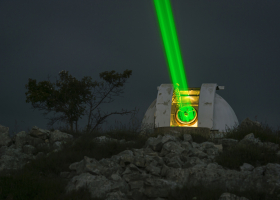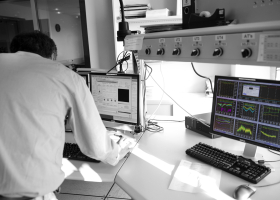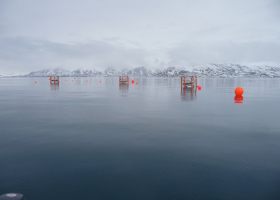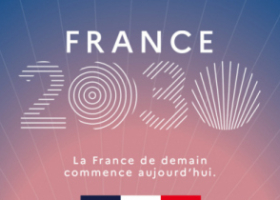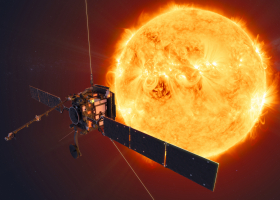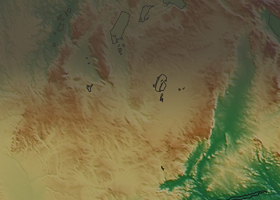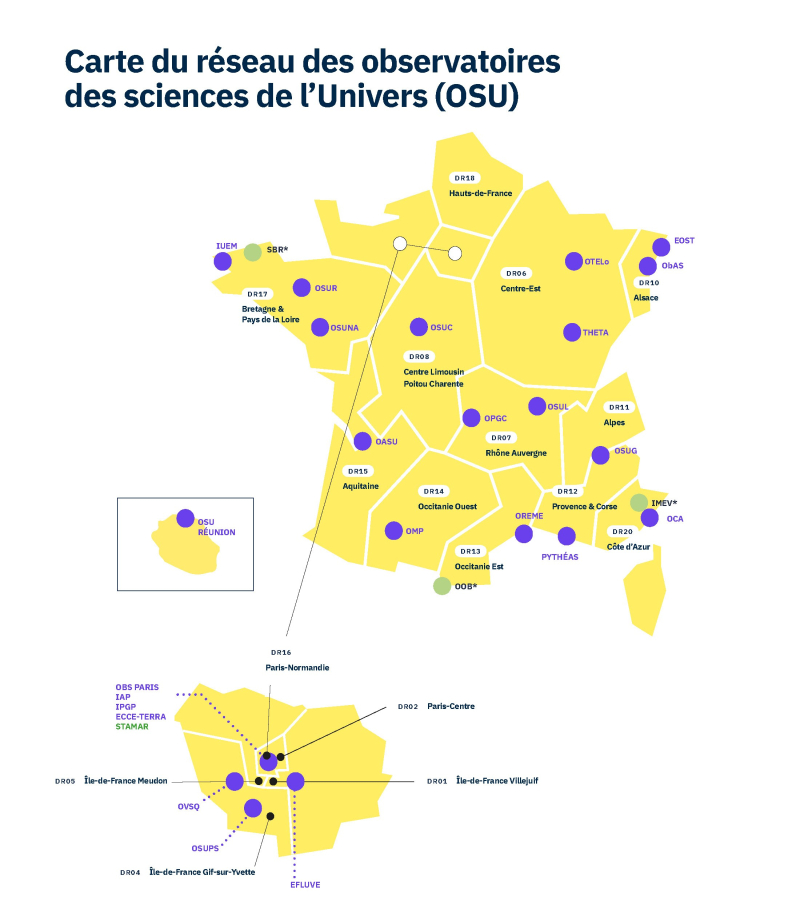Listes des laboratoires
( regroupés par OSU, voir carte ci-dessous)
ECCE TERRA - Observatoire des sciences de l'Univers Paris-Centre Ecce Terra (Sorbonne Université - CNRS)
- ISTEP - Institut des sciences de la Terre de Paris
- LG-ENS - Laboratoire de géologie de l'École normale supérieure
- LOCEAN - Laboratoire d'océanographie et du climat : expérimentations et approches numériques
- METIS - Milieux environnementaux, transferts et interactions dans les hydrosystèmes et les sols
- LATMOS - Laboratoire atmosphères et observations spatiales
- LMD - Laboratoire de météorologie dynamique
- M2C - Morphodynamique Continentale et Côtière
EOST- École et Observatoire des sciences de la Terre (Université de Strasbourg- CNRS)
- ITES - Institut Terre environnement Strasbourg
EFLUVE - Enveloppes fluides : de la ville à l’exobiologie (Université Paris-Est Créteil- CNRS)
- LISA - Laboratoire interuniversitaire des systèmes atmosphériques
IAP - Institut d'astrophysique de Paris (Sorbonne Université- CNRS)
IPGP - Institut de physique du globe de Paris (Université Paris-Cité - CNRS)
IUEM - Institut universitaire européen de la Mer (Université de Bretagne Occidentale - CNRS)
- LEMAR - Laboratoire des sciences de l'environnement marin
- LGO - Laboratoire géosciences océan
- LOPS - Laboratoire d'océanographie physique et spatiale
OASU – Observatoire aquitain des sciences de l’Univers (Université de Bordeaux - CNRS)
- EPOC - Environnements et paléoenvironnements océaniques et continentaux
- LAB - Laboratoire d'astrophysique de Bordeaux
- LIENSs - Littoral environnement et société
ObAS - Observatoire astronomique de Strasbourg (Université de Strasbourg - CNRS)
OBS. PARIS - Observatoire de Paris (Université Paris Sciences et Lettres - CNRS)
- GEPI - Galaxies, étoiles, physique, instrumentation
- IMCCE - Institut de mécanique céleste et de calcul des éphémérides
- LERMA - Laboratoire d'étude du rayonnement et de la matière en astrophysique et atmosphères
- LESIA - Laboratoire d'études spatiales et d'instrumentation en astrophysique
- LUTH - Laboratoire Univers et théories
- SYRTE - Systèmes de référence temps-espace
- ORN – Observatoire radioastronomique de Nançay
OCA – Observatoire de la Côte d’Azur (Université de la Côte d’Azur - CNRS)
- GEOAZUR - GéoAzur
- LAGRANGE - Laboratoire J-L Lagrange
OPGC - Observatoire de physique du globe de Clermont-Ferrand (Université Clermont Auvergne - CNRS)
- LAMP - Laboratoire de météorologie physique
- LMV- Laboratoire magmas et volcans
OREME - Observatoire de recherche méditerranéen de l'environnement (Université Montpellier - CNRS))
- GEOSCIENCES MONTP. - Géosciences Montpellier
- HSM - HydroSciences Montpellier
OMP - Observatoire Midi-Pyrénées (Université Toulouse III - CNRS)
- CESBIO - Centre d'études spatiales de la biosphère
- CNRM - Centre national de recherches météorologiques
- GET - Géosciences Environnement Toulouse
- IRAP - Institut de recherche en astrophysique et planétologie
- LAERO - Laboratoire d'aérologie
- LEGOS - Laboratoire d'études en géophysique et océanographie spatiales
- CEFREM - Centre de formation et de recherche sur les environnements méditerranéens
- CECI - Climat, environnement, couplages et incertitudes
OSUC - Observatoire des sciences de l'Univers en région Centre-Val de Loire (Université d’Orléans - CNRS)
- ISTO - Institut des sciences de la Terre d'Orléans
- LPC2E - Laboratoire de physique et chimie de l'environnement et de l'Espace
- ORN – Observatoire Radioastronomique de Nançay
OSUG - Observatoire des sciences de l'Univers de Grenoble (Université Grenoble Alpes - CNRS)
- IGE- Institut des géosciences de l'environnement
- IPAG- Institut de planétologie et d'astrophysique de Grenoble
- ISTERRE- Institut des sciences de la Terre
OSUL - Observatoire des sciences de l'Univers de Lyon (Université Lyon 1 - CNRS)
- CRAL - Centre de recherche astrophysique de Lyon
- LGL-TPE - Laboratoire de géologie de Lyon : Terre, Planètes, Environnement
OSUNA - Observatoire des sciences de l'Univers Nantes Atlantique (Nantes Université - CNRS)
- LPG - Laboratoire de planétologie et géosciences
OSUPS - Observatoire des sciences de l'Univers Paris-Saclay (Université Paris-Saclay - CNRS)
- AIM - Astrophysique, instrumentation, modélisation
- GEOPS Géosciences Paris-Saclay
- IAS - Institut d'astrophysique spatiale
OSUR - Observatoire des sciences de l'Univers de Rennes (Université de Rennes - CNRS)
- GEOSCIENCES RENNES - Géosciences Rennes
OSU-REUNION - Observatoire des sciences de l'Univers de la Réunion (Université de la Réunion - CNRS)
- LACY - Laboratoire de l'Atmosphère et des Cyclones
OTELO - Observatoire Terre et environnement de Lorraine (Université de Lorraine - CNRS)
- CRPG - Centre de recherches pétrographiques et géochimiques
- GEORESSOURCES - GeoRessources
- LIEC - Laboratoire Interdisciplinaire des Environnements Continentaux
OVSQ - Observatoire des sciences de l'Univers de l'UVSQ (Université de Versailles Saint-Quentin-en-Yvelines - CNRS)
- LSCE - Laboratoire des Sciences du Climat et de l'Environnement
- LATMOS - Laboratoire Atmosphères et Observations Spatiales
PYTHEAS - Institut Pythéas (Aix-Marseille Université - CNRS)
- CEREGE- Centre européen de recherche et d'enseignement de géosciences de l'environnement
- LAM - Laboratoire d'astrophysique de Marseille
- MIO - Institut méditerranéen d'Océanologie
THETA – Terre Homme environnement temps astronomie (Université de Franche-Comté - CNRS)
- UTINAM - Univers, temps-fréquence, interfaces, nanostructures, atmosphère et environnement, molécules
STAMAR - Stations marines (Sorbonne Université - CNRS)
- IMEV – Institut de la mer de Villefranche
- OOB - Observatoire océanologique de Banyuls-sur-Mer
- SBR – Station biologique de Roscoff
- LOMIC - Laboratoire d'océanographie microbienne
- LOV - Laboratoire d'océanographie de Villefranche
Hors OSU (Université de Lille - CNRS)
- LOA - Laboratoire d'optique atmosphérique
- LOG - Laboratoire d'océanologie et de géosciences
Fédération de recherche
- IPSL - Institut Pierre Simon Laplace
